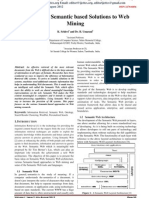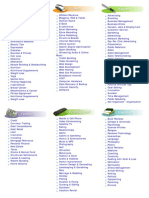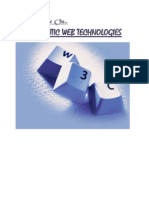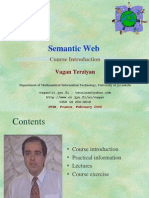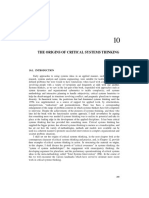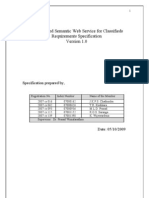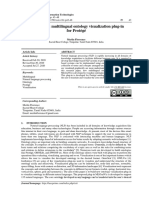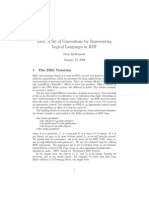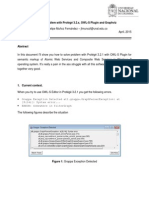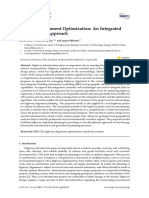Professional Documents
Culture Documents
A Survey Paper On Ontology Concepts in Semantic Web Technology and It's Applications
Original Title
Copyright
Available Formats
Share this document
Did you find this document useful?
Is this content inappropriate?
Report this DocumentCopyright:
Available Formats
A Survey Paper On Ontology Concepts in Semantic Web Technology and It's Applications
Copyright:
Available Formats
Volume 3, Issue 6, June – 2018 International Journal of Innovative Science and Research Technology
ISSN No:-2456-2165
A Survey Paper on Ontology Concepts in Semantic
Web Technology and it’s Applications
V.Anitha Dr.T.Menaka devi
Ph.D Scholar, Department of Electronics and Professor, Department of Electronics and
Communication Engineering Communication Engineering
Adhiyamaan College of Engineering, Hosur, Tamil Nadu, Adhiyamaan College of Engineering, Hosur, Tamil Nadu,
India. India.
Abstract:- Semantic Web is an advanced form of the “Web Service” concept was introduced in web
World Wide Web (WWW) to collect, manipulate and technology to amplify the incorporation and interoperability to
interpret the information. It is an intelligent incarnation access the information. Web services become extremely
that provides classification, identical access to the property trending in production in a small span because of its dynamic
and transforms the available information into machine nature but some authorization problems were identified [1]
readable format. To make up the information in to because of the heavy raise in numeral services with the
machine readable format, “Ontology” concept was passage of time. To solve some existing web based problems
introduced by the semantic web technology. Ontology like information filtering, confidentiality, security and
concept is approved by World Wide Web Consortium exaggeration of the context that is available in arrangement
(W3C). It is a collection of interrelated concepts of above the web, a solution “Semantic Web” base on semantic
semantic web that are modeled based on the defined finite concept was designed [2] by Tim Berners Lee. Semantic web
set of conditions in information integration and knowledge is a shared exertion by the W3C and it can be used to
management. Ontology provides solutions to some issues encourage the universal format for data. The basic concept of
like document detection, end-to-end service validation, semantic web is presented in Fig.1. It cancels vagueness from
endorsement, concealment, association, data veracity and available data format which has been constituted on the World
allocation of isolated parts of information problems. It is Wide Web.
said to be a good technique to embody the available data in
machine processable format. Implementing ontology in an
OWL (Ontology Web Language) depends on some
ontology tool support which is said to be complex and time
consuming process. Several research fellows and
development organizations have designed a number of
ontology building environments and algorithms for
different applications. A survey of various ontology
concepts, building environments, ontology designing tools
and the algorithms developed in semantic web technology
is presented in the paper which mainly concentrates on the
real time applications.
Keywords:- Semantic Web, Ontology, World Wide Web
Consortium (W3C), Web Ontology Language (OWL), Satellite
data.
I. INTRODUCTION
Fig 1:- Basic concept of Semantic Web
World Wide Web (WWW) is an information space
Semantic web allow the enclosure of the semantic
which provides the user to access and share the information
substance that describe the format in the web pages. Semantic
via internet. It consists of three standard representations
Web has proposed the idea of “Ontology” which is used to
namely Uniform Resource Locator (URL), HyperText
structure the information in to machine processable format [3].
Transfer Protocol (HTTP) and HyperText Mark-up Language
The three basic categories in which the ontology concept is
(HTML). The information that is available over the web are in
subdivided are namely given as Ontology Instance (OI),
various formats like audio, video, text and image are presented
Natural Language Ontology (NLO) and Domain Ontology
in HTML. These formats presented are said to be
(DO). The ontology cloud is presented in Fig.2. Produced
individualistic in defining and forming the denotation of the
linguistic token which are acquired from natural language
context. Generally the information accessible are said to be
proclamation can be related by NLO language, the knowledge
unstructured so it is very tricky to extort and valid the
of a particular domain is represented by using DO and
information. Although some hunt engines and display scrapers
automatic object based web pages are generated by OI.
are developed they are not said to be resourceful and require
extreme physical pre-processing like crafting a schematic
concept, clearing uncooked data, physically classifying the
credentials into catalog and post processing.
IJISRT18JU108 www.ijisrt.com 181
Volume 3, Issue 6, June – 2018 International Journal of Innovative Science and Research Technology
ISSN No:-2456-2165
said to be an alternative for forming ontologies except there
are unique causes to use previous languages like DAML+OIL
(compatibility, etc). Observe with producing OWL ontologies
demonstrates that though OWL is very animated, in some
areas it is not expedient to use it. Occasionally we does not
depend up on the usage of all the OWLs complicated concepts.
But submission always believes that we could and try to
rationale over these thoughts.
Developers of OWL envisages the difficulty and
presented three OWL genus, these are the subsets of OWL
with diminishing perspicuity namely OWL Full, OWL DL and
OWL Lite as shown in the Venn diagrammatic representation
Fig.3. Nevertheless, there are proposals to afford easy
understandable languages than others OWL Lite, is said to be
the least animated of all the other three. This paper is
structured as follows; Section II describes about the various
ontology concepts, building environments and developed
Fig 2:- The Ontology Cloud algorithms of semantic web technology in a brief manner.
Section III presents a comparison result of the present
Constructing an ontology concept for any application is ontology development algorithms. Finally section IV
extremely challengeable research topic since it relays on concludes along with the future enhancement.
withdrawal of information from the network and processes it
to the machine readable format. RDF, OWL etc are some of II. LITERATURE SURVEY
the supporting languages used to construct ontology in order to
visibly convey semantic stuffing and organize their margins. Semantic Web is a concept introduced to improve
The developed ontologies are connected in a manner to each human to machine communication by illustrating the data in a
other such that it extracts the available concrete information. machine readable manner. Ontologies in semantic web are
Due to the enlargement of complex handing out apparatus and accompanied by documents in an ontology language [6].
large lexical possessions ontology plays a better contribution Ontology tools are worn for creating, controlling, interpreting
in the present scenario. Some concepts that are projected and and amalgamation of ontologies. They are very important for
urbanized ontology based resolution are named as Semantic developing an ontology concept or an algorithm and
Desktop [4], Semantic Security Web Services (SSWS) and implementing them in real time applications [7]. A survey of
Cultural Heritage [5]. ontology development tools is presented in this paper along
with the general ontology tools and its properties. Several
The concept of “ontology” is defined in a general development apparatus are unwrapped sources excluding Top
terminology for developers who need to distribute information Braid Composer. The development platform like Web Onto,
in that particular field/area. It encompasses some concepts in We bode and NeOn toolkit offers backup management
domain of machine interoperability and relations between functionalities whereas; SWOOP and NeOn toolkit affords
them. The reasons that why one should develop ontology versioning attributes. With the exception of OilEd and
concept is given by: OntoEdit, other tools offers atmosphere to construct ontologies
collectively. The tools like protege and NeOn grants much
To allocate regular accepting of the formation of functionality for developing ontologies.
information among public and software perspective.
To allow reuse of particular domain familiarity. The OWL is designed to process the content of the data
To construct the domain supposition unambiguous. and present that information to the humans [8] for further
To divide domain awareness from the equipped application areas. OWL achieves a better device
awareness. interpretability of network substance than that sustained by
To investigate domain familiarity. other files like XML, RDF, and Schema (RDF-S) because it
supplies an added terminology along with a reserved
The Web Ontology Language (OWL) is a W3C semantics. OWL has three gradually more significant
commendation for specifying the concepts of ontologies. This sublanguages namely: OWL Lite, OWL DL (Description
language has been considered to assist superior machine Logic), and OWL Full. A document provides the preface to
interpretability than the present and previous solutions. It OWL by relating the quality of each of the sublanguages of
presents more widespread terminology than the plain OWL proposed by Deborah L. Mc Guinness. Some basic facts
Extensible Markup Language (XML), Resource Description of RDF Schema are necessary for accepting the proposed
Framework (RDF) or RDF Schema and improved facilities for concept. More complete metaphors and widespread examples
expressing the semantics than the presented languages. OWLS on the characteristics of Web Ontology Language are also
has its heredity in DARPA Agent Markup Language + discussed in this paper.
Ontology Interchange Language (DAML+OIL) which is a
representation language, that conception, adjust and
simplified, were integrated into OWL. Presently, the OWL is
IJISRT18JU108 www.ijisrt.com 182
Volume 3, Issue 6, June – 2018 International Journal of Innovative Science and Research Technology
ISSN No:-2456-2165
Fig 4:- Architecture of an ontology based data retrieval
Fig 3:- Sublanguages of OWL system
Peter.F.Patel et.al.,[9] has presented a concept of The interoperability of sensor input data and semantics
Semantic Web Rule Language (SWRL) that combines the of the same data are considered by Dr.Sunitha Abburu
sublanguages of web ontology language (OWL) and Rule et.al.,[11] through domain ontologies. The proposed
Markup Language (RML). It contains OWL DL and OWL methodology provides an effective technical solution by
Lite, which are the sublanguages of OWL aligned with solving some issues like semantic diverseness in the course of
unary/binary data log, which are the sublanguages of the semantic ontology. Such knowledge provides ability to
RML. This paper implements the number of OWL maxims by exchange and make use of information, capability to build
including described rules. Thus the proposed method enables knowledge through data repossession by increasing a powerful
the rules by combining them with an OWL knowledge base notion with the help of domain ontologies. The satellite data
system. A complete explanation of the OWL model theoretic semantic interoperability has been accessed by implementing a
semantics is presented in this paper in order to make available four phase methodology. This paper presents an evaluation by
a recognized significance for OWL ontologies and the rules connecting and assembling the several ontologies to turn up at
for developing. The rules projected are said to be in the a basic ontology terminology for sensor annotations. Indian
structure of an insinuation among a predecessor (stiff) and the Meteorological satellite observation data were used by this
resultant (chief). Such that every time when the state of affairs author as a distinctive model in this paper to demonstrate the
are individual in the predecessor seize, then the state of affairs proposed concepts of ontology.
specified in the resultant must be seized too.
The available sources are categorized into three
Major elements of the architecture of a data retrieval concepts namely data, information and knowledge. Each of
system is presented by Jose A. Piedra et.al., [10]. With the their formats differs from the other where the structure of
intention of achieving a supple and active image retrieval knowledge is said to be highly complex to design than the
system, this architecture has been designed which incorporates other two. Due its complex structure it is difficult to design the
web equipments with new sample pattern detection systems knowledge management concept for traditional information
functional to satellite images [PGC05] as shown in Fig.4. and hard to achieve a common structure for capturing the
More efficiently the picture, sensor and satellite characteristics particular data from the mixed data sources. The basic
can be imported/exported and updated. The algorithms elements of knowledge resource in the semantic web are
developed and the architectures implemented can also be presented in Fig.5. Ontology is the best semantic technology to
imported/exported and advanced/enhanced from the represent knowledge. It provides uniform data structure for the
organization. To make the proposed system capable of knowledge acquired from mixed data structure.
importing/exporting facilities it has to be furnished with the
development methodologies for data and knowledge exchange. It enables the sharing of knowledge within and out of the
Well known web technologies such as XML [W3C07] are organizations [12] and also supports music applications [13].
used for data switch over, and the web ontology Language is Ontology provides a supportive platform for integration of
used for knowledge switch over. related knowledge sources. The proposed ontology is
implemented by using domain ontology (DO) provides an
effective, efficient and good framework for knowledge
management systems by addressing some major issues of the
existing and proposed systems.
IJISRT18JU108 www.ijisrt.com 183
Volume 3, Issue 6, June – 2018 International Journal of Innovative Science and Research Technology
ISSN No:-2456-2165
heterogeneity. It provides an efficient outcome by reaching
interoperability, semantic data recovery and successful
visualization with the help of domain ontologies.
Suresh Babu Golla et.al presented an approach [15] that
provides a solid relation connecting three diverse ontologies
associated to application areas like sickness, spaces and
surroundings integrated in a single ontology algorithm. It links
the real time apparatus that are inbuilt surrounded by the
semantic knowledge base and also explains the
interrelationships between them. The proposed methodology
provides a sturdy base for beginning a fundamental
requirement for a significant healthcare choice building system
and its applications. A wide range of best practices of the data
sets facilitates the advocacy of the proposed loomed for
enhanced admiration, accepting and a range of conclusions in
the medical applications. Thus the proposed method is related
to health mapping methods, reusability of patient’s data and its
future applications by solving interoperability issues. It is
Fig 5:- Knowledge resource developed according to mapping the available data features
with the developed concepts of ontology by creating the
M.R.Nayak has identified that the challenges in ocean semantic data along with an implication engine for other
information systems are Semantic heterogeneity and uncertainties to make it user friendly.
information overload. The solution is categorized using
Semantic Web technologies, taking the inputs from mapping III. COMPARISON AND DISCUSSION
domain ontologies. The concept of interoperability is being
addressed through ontologies, which are widely used as a This paper discusses a widespread survey of the ontology
means for solving the information heterogeneity problems in expansion tools and algorithms for various applications like
this paper [14]. A methodology to address the interoperability Satellite image retrieval system, Ocean data applications,
of sensor data and semantics of the data is also considered. Knowledge based management, Cricket video and Musical
applications. Functions and features of various ontology
development tools like TopBraid Composer, SWOOP, NeOn,
OilEd, protege, OntoEdi, WebOnto and WebODE are
discussed in this paper. Many tools are open source and
provide versioning features. The tools protege and NeOn
provide a better environment to build ontologies and backup
management functionalities for developing ontologies.
The ontology development algorithms like Friend Of A
Friend (FOAF), Simple Knowledge Organization System
(SKOS), GeoNames ontologies, Platform for Ocean
Knowledge Management (POKM) and automatic Extract,
Transform and Load (ETL) are discussed in this paper. The
ontology development algorithms are mainly focused on
addressing the accessed data from the sensor interoperability
and semantics of the satellite information. The proposed
ontologies offers interoperability, competence to put up
understanding base and provide the frame work for data
retrieval system by developing an effective algorithm through
the concept of ontology.
Fig 6:- Multiple ontology mapping and merging technique
IV. CONCLUSION AND FUTURE
The heterogeneities between various sensor networks are ENHANCEMENT
reduced through ontology mapping with sensor vocabulary.
Sensor Observation Service (SOS) offers an extensive array of In present scenario, with the sensor scientifically
interoperability potential for each and every sensor, sensor processed improvements in coastal ocean examination more a
policy, and networked assemblage of sensors in real-time, number of physical, meteorological, chemical, biological and
annals or virtual atmosphere, through Semantic Sensor geological attributes are being experimented and prepared to
ontology (SSN) by implementing mapping and merging be available. The provincial relations is presently occupied in
technique as shown in Fig.6. The current study allows a comprehensive and incorporate textures such data unruffled
valuable and efficient scientific resolution to solve the and supplied from various associations, there is a necessity for
problems for voluminous data, in terms of semantic direction and development platform for data naming
IJISRT18JU108 www.ijisrt.com 184
Volume 3, Issue 6, June – 2018 International Journal of Innovative Science and Research Technology
ISSN No:-2456-2165
conference to make it easy for identification, accessing, proper Ocean Satellite Image Retrieval System”, Dpto. De
usage and depository of the data. The multiple ontology Lenguajes Y Computaci´On. Universidad De Almer´Ia,
mapping and merging techniques are also discussed in this 2010.
paper which are said to be more efficient and user friendly.
The future research of this work is to develop ontology based [11] Sunitha ABBURU, Nitant DUBE, Ravindranath Nayak
architecture in semantic web technology to convert the MIYAR and Suresh Babu GOLLA, “An Ontology Based
available unstructured satellite data into the structured one i.e., Methodology for Satellite Data Semantic Interoperability”,
the machine readable format and use it for the ocean Advances in Electrical and Computer Engineering Volume
applications. 15, Number 3, 2015.
REFERENCES [12] Sunitha Abburu and G Suresh Babu, “A Framework for
Ontology Based Knowledge Management”, International
[1] Grit, Dr, Son, N, & Andrew, T, 2004, “OWL-S Semantics Journal of Soft Computing and Engineering (IJSCE) ISSN:
of Security Web Services: a Case Study”, Springer-Verlag 2231-2307, Volume-3, Issue-3, July 2013.
J. Davies et al. (Eds.): ESWS, LNCS 3053, Berlin
Heidelberg Germany, pp. 240–253. [13] Sunitha Abburu, “Knowledge based Semantic Annotation
Generation of Music”, International Journal of Computer
[2] Tim, B. Lee, James, H & Ora, L, The Semantic Web, A Applications (0975 – 888) Volume 47– No.8, June 2012.
new form of Web content that is meaningful to computers
will unleash a revolution of new possibilities, Retrieved [14] Nitant Dube B, M.R.Nayak and Sunitha Abburu, “Ocean
data from the available website: Data Techniques And Standards – Tools and Analysis
http://www.geodise.org/useful_links/link_semantic.htm, Using Semantic Sensor Ontology - An Emerging Area -
June 30, 2007. Indian Scenario”, ISPRS TC VIII International Symposium,
Hyderabad, India, December 9 – 12, 2014.
[3] Heiner S, “Approximate Information Filtering on the
Semantic Web”, pp. 114–128, Springer Verlag M. Jarke et [15] Suresh Babu Golla And Dr. Sunitha Abburu, “Ontology-
al. (Eds.): KI, LNAI 2479, Berlin Heidelberg Germany, Driven Knowledge-Based Health-Care System An
2002. Emerging Area - Challenges And Opportunities – Indian
Scenario”, The International Archives Of The
[4] Mark S, Pierre S, Leo S & Andreas D, “Increasing Search Photogrammetry, Remote Sensing And Spatial Information
Quality with the Semantic Desktop in Proposal Sciences, Volume Xl-8, December 2014.
Development”, In the proceedings of Practical Aspects of
Knowledge Management 6th International Conference.
(PAKM), Vienna Austria, 2006.
[5] V R Benjamins, J Contreras, M Blázquez, J M Dodero, A
Garcia, E Navas, F Hernandez & C Wert, “Cultural
Heritage and the Semantic Web”, Springer Verlag J. Davies
et al. (Eds.): ESWS LNCS 3053, Heidelberg Germany,
2004, pp. 433-444.
[6] T R Gruber, “A Translation Approach to Portable
Ontology Specifications,” Knowledge Acquisition, ACM,
2009, Vol.3, Issue 2, pp. pp. 199−220.
[7] L. Laera and V. Tamma, “Deliverable 1.3: A survey on
ontology tools” Available at http://ontoweb.aifb.uni-
karlsruhe.de/About/Delive rables/ D13\_v1-0.zip.
[8] Deborah L Mc Guinness and Frank van Harmelen, “OWL
Web Ontology Language Overview”, W3C
Recommendation 10 February 2004.
[9] Ian Horrocks, Peter F. Patel-Schneider and Harold Boley,
“SWRL: A Semantic Web Rule Language Combining
OWL and RuleML”, W3C Member Submission available in
the website Online:
http://www.w3.org/Submission/2004/SUBM-SWRL-
20040521, 21 May 2004.
[10] Jes´Us M Almendros-Jim´Enez and Jos´E A Piedra and
Manuel Cant´On, “An Ontology-Based Modeling of an
IJISRT18JU108 www.ijisrt.com 185
You might also like
- Semantic Web Implementation and Unifying LogicDocument17 pagesSemantic Web Implementation and Unifying LogicMohamed Kabir KonéNo ratings yet
- Brain Computers Mind Speech Thought Humans Animals Machines Semantic Web Artificial Intelligence AIDocument33 pagesBrain Computers Mind Speech Thought Humans Animals Machines Semantic Web Artificial Intelligence AIFranciscoNo ratings yet
- Provenance in Data Science: Leslie F. Sikos Oshani W. Seneviratne Deborah L. Mcguinness EditorsDocument119 pagesProvenance in Data Science: Leslie F. Sikos Oshani W. Seneviratne Deborah L. Mcguinness EditorsgusNo ratings yet
- A Survey of Semantic Based Solutions To Web MiningDocument8 pagesA Survey of Semantic Based Solutions To Web MiningInternational Journal of Application or Innovation in Engineering & ManagementNo ratings yet
- Overview of Ontology Concepts and ApplicationsDocument28 pagesOverview of Ontology Concepts and ApplicationsWambasi Wang'anya Aineah50% (2)
- Aarne Ranta - Implementing Programming Languages. An Introduction To Compilers and Interpreters (2012, College Publications)Document226 pagesAarne Ranta - Implementing Programming Languages. An Introduction To Compilers and Interpreters (2012, College Publications)Deepa TilwaniNo ratings yet
- Semantic Web: Seminar ReportDocument13 pagesSemantic Web: Seminar ReportgbrmmtNo ratings yet
- Levels of AbstractionDocument11 pagesLevels of AbstractionFoster TadiwanasheNo ratings yet
- Text, Context and KnowledgeDocument38 pagesText, Context and KnowledgeAlfadil AltahirNo ratings yet
- Twelve Systems Engineering RolesDocument9 pagesTwelve Systems Engineering RolesShakoor MalikNo ratings yet
- Text Processing (Complete)Document100 pagesText Processing (Complete)WeiYewHuongNo ratings yet
- Knowledge InferenceDocument122 pagesKnowledge InferencetamizhanpsNo ratings yet
- Engineering Design Knowledge Representation Based On Logic and ObjectsDocument19 pagesEngineering Design Knowledge Representation Based On Logic and ObjectsnuesteNo ratings yet
- Word Semantics, Sentence Semantics and Utterance SemanticsDocument11 pagesWord Semantics, Sentence Semantics and Utterance SemanticsАннаNo ratings yet
- Semantic - Based Querying Using Ontology in Relational Database of Library Management SystemDocument12 pagesSemantic - Based Querying Using Ontology in Relational Database of Library Management SystemijwestNo ratings yet
- Knowledge Graph Considered Harmful For Ontology PDFDocument11 pagesKnowledge Graph Considered Harmful For Ontology PDFSachin SreeramNo ratings yet
- A Pamphlet Against R. Computational Intelligence With Guile Scheme.Document87 pagesA Pamphlet Against R. Computational Intelligence With Guile Scheme.Maciek100% (1)
- Knowledge Representation Methods and ApplicationsDocument18 pagesKnowledge Representation Methods and ApplicationsanwarussaeedNo ratings yet
- Taxonomy Tools (SLA 2019)Document61 pagesTaxonomy Tools (SLA 2019)Andrew CNo ratings yet
- 2008 The Modern Algebra of Information RetrievalDocument332 pages2008 The Modern Algebra of Information RetrievalAkashNo ratings yet
- Ontology Creation: A Scratch Guide To Creating An OntologyDocument21 pagesOntology Creation: A Scratch Guide To Creating An OntologyWilliam C. De Souza CarvalhoNo ratings yet
- Computers in Industry: Emilio M. San Filippo, Farouk Belkadi, Alain BernardDocument13 pagesComputers in Industry: Emilio M. San Filippo, Farouk Belkadi, Alain BernardDwi YanyuniNo ratings yet
- Semantic Problems of Thesaurus Mapping: Martin DoerrDocument29 pagesSemantic Problems of Thesaurus Mapping: Martin DoerrAnonymous z2QZEthyHoNo ratings yet
- An Ontology-Based NLP Approach To Semantic Annotation of Annual ReportDocument4 pagesAn Ontology-Based NLP Approach To Semantic Annotation of Annual ReportRajesh KumarNo ratings yet
- Employing A Domain Specific Ontology To Perform Semantic SearchDocument13 pagesEmploying A Domain Specific Ontology To Perform Semantic Searchmona4No ratings yet
- A Comparative Study of Ontology Building Tools in Semantic Web ApplicationsDocument13 pagesA Comparative Study of Ontology Building Tools in Semantic Web ApplicationsijwestNo ratings yet
- Natural Computing Hitoshi Iba Editor, Nasimul Noman Editor DeepDocument437 pagesNatural Computing Hitoshi Iba Editor, Nasimul Noman Editor DeepJhovanny AlexanderNo ratings yet
- Introduction To Semantic WebDocument28 pagesIntroduction To Semantic WebYashwanth RaoNo ratings yet
- Collaborative Tagging SystemsDocument8 pagesCollaborative Tagging Systemsbc2255No ratings yet
- Semanti Web TechnologiesDocument11 pagesSemanti Web TechnologiesHarika MnNo ratings yet
- From Knowledge Abstraction to Management: Using Ranganathan’s Faceted Schema to Develop Conceptual Frameworks for Digital LibrariesFrom EverandFrom Knowledge Abstraction to Management: Using Ranganathan’s Faceted Schema to Develop Conceptual Frameworks for Digital LibrariesNo ratings yet
- Knowledge Representation Approaches in Propositional LogicDocument134 pagesKnowledge Representation Approaches in Propositional LogicShrey MisraNo ratings yet
- An Invitation To General Algebra and Invitation To Construction 3.0Document469 pagesAn Invitation To General Algebra and Invitation To Construction 3.0Debraj SarkarNo ratings yet
- Applications of Link Prediction in Social Networks A ReviewDocument18 pagesApplications of Link Prediction in Social Networks A Reviewle mr100% (1)
- Ontology Mapping - An Integrated Approach: Abstract. Ontology Mapping Is Important When Working With More Than OneDocument15 pagesOntology Mapping - An Integrated Approach: Abstract. Ontology Mapping Is Important When Working With More Than OneIanus72No ratings yet
- Ontology Engineering: Series Editors: Ying Ding, Indiana UniversityDocument122 pagesOntology Engineering: Series Editors: Ying Ding, Indiana UniversityMoi ChezMoiNo ratings yet
- Tutorial On Ontological Engineering Part 2: Ontology Development, Tools and LanguagesDocument28 pagesTutorial On Ontological Engineering Part 2: Ontology Development, Tools and LanguagesCarvalho BentoNo ratings yet
- Semantic Web IntroductionDocument35 pagesSemantic Web IntroductionkhongminhphongNo ratings yet
- Lecture Notes On Ontology Engineering Concepts: What Is An Ontology?Document24 pagesLecture Notes On Ontology Engineering Concepts: What Is An Ontology?Tshireletso PhuthiNo ratings yet
- Seminar Report On Bit TorrentDocument24 pagesSeminar Report On Bit TorrentAkshay KandulNo ratings yet
- Automatic Ontology Creation by Extracting Metadata From The Source CodeDocument7 pagesAutomatic Ontology Creation by Extracting Metadata From The Source CodeMadavee JinadasaNo ratings yet
- A Fuzzy Ontology and Its Application To News SummarizationDocument22 pagesA Fuzzy Ontology and Its Application To News Summarizationgula_gula100% (1)
- Asset Pricing Markus BrunnermeierDocument159 pagesAsset Pricing Markus BrunnermeierFilipeRodriguesDosSantosNo ratings yet
- Semantic Search and Social-Semantic Search As Cooperative ApproachDocument5 pagesSemantic Search and Social-Semantic Search As Cooperative ApproachEditor IJRITCCNo ratings yet
- Semantic WebDocument318 pagesSemantic WebAbhijitNo ratings yet
- A Comprehensive Survey of Graph Neural Networks PDFDocument22 pagesA Comprehensive Survey of Graph Neural Networks PDFgcNo ratings yet
- Pubby - A Linked Data Frontend For SPARQL EndpointsDocument4 pagesPubby - A Linked Data Frontend For SPARQL EndpointsPrabhu AlakannanNo ratings yet
- Des Form 2013Document220 pagesDes Form 2013Panti BahagiyaNo ratings yet
- Ontology SeminarDocument95 pagesOntology SeminarAmrutNo ratings yet
- Tuyeras Thesis 1 03 PDFDocument353 pagesTuyeras Thesis 1 03 PDFDaniel AlejandroNo ratings yet
- 05 - Dretske, FredDocument12 pages05 - Dretske, FredJuancho HerreraNo ratings yet
- Ontology Based E-Healthcare Information Retrieval System: A Semantic ApproachDocument5 pagesOntology Based E-Healthcare Information Retrieval System: A Semantic ApproachEditor IJRITCCNo ratings yet
- AI & Expert System ch12Document13 pagesAI & Expert System ch12Ahmed HamdyNo ratings yet
- Patrick Suppes. The Limits of Rationality PDFDocument17 pagesPatrick Suppes. The Limits of Rationality PDFspain1492No ratings yet
- Understanding the Semantic Web in BriefDocument86 pagesUnderstanding the Semantic Web in BriefAnkur BiswasNo ratings yet
- Agent-Oriented Information SystemsDocument220 pagesAgent-Oriented Information SystemsShahzad Abbas100% (1)
- Cubos OlapDocument79 pagesCubos OlapRiveros EvelynNo ratings yet
- Semantic Web OntologyDocument12 pagesSemantic Web OntologyZarana KananiNo ratings yet
- Unit Iv: Syllabus: Knowledge Representation: Introduction, Approaches To Knowledge Representation, KnowledgeDocument14 pagesUnit Iv: Syllabus: Knowledge Representation: Introduction, Approaches To Knowledge Representation, KnowledgeDr-Kiran Sree PokkuluriNo ratings yet
- Kluza-Nalepa2019 Article FormalModelOfBusinessProcessesDocument19 pagesKluza-Nalepa2019 Article FormalModelOfBusinessProcessesIshani JhunjhunwalaNo ratings yet
- Systems ApproachesDocument40 pagesSystems ApproachesJuan Camilo ZapataNo ratings yet
- Securing Document Exchange with Blockchain Technology: A New Paradigm for Information SharingDocument4 pagesSecuring Document Exchange with Blockchain Technology: A New Paradigm for Information SharingInternational Journal of Innovative Science and Research TechnologyNo ratings yet
- The Effect of Time Variables as Predictors of Senior Secondary School Students' Mathematical Performance Department of Mathematics Education Freetown PolytechnicDocument7 pagesThe Effect of Time Variables as Predictors of Senior Secondary School Students' Mathematical Performance Department of Mathematics Education Freetown PolytechnicInternational Journal of Innovative Science and Research TechnologyNo ratings yet
- Perceived Impact of Active Pedagogy in Medical Students' Learning at the Faculty of Medicine and Pharmacy of CasablancaDocument5 pagesPerceived Impact of Active Pedagogy in Medical Students' Learning at the Faculty of Medicine and Pharmacy of CasablancaInternational Journal of Innovative Science and Research TechnologyNo ratings yet
- Formation of New Technology in Automated Highway System in Peripheral HighwayDocument6 pagesFormation of New Technology in Automated Highway System in Peripheral HighwayInternational Journal of Innovative Science and Research TechnologyNo ratings yet
- Supply Chain 5.0: A Comprehensive Literature Review on Implications, Applications and ChallengesDocument11 pagesSupply Chain 5.0: A Comprehensive Literature Review on Implications, Applications and ChallengesInternational Journal of Innovative Science and Research TechnologyNo ratings yet
- Exploring the Clinical Characteristics, Chromosomal Analysis, and Emotional and Social Considerations in Parents of Children with Down SyndromeDocument8 pagesExploring the Clinical Characteristics, Chromosomal Analysis, and Emotional and Social Considerations in Parents of Children with Down SyndromeInternational Journal of Innovative Science and Research TechnologyNo ratings yet
- Intelligent Engines: Revolutionizing Manufacturing and Supply Chains with AIDocument14 pagesIntelligent Engines: Revolutionizing Manufacturing and Supply Chains with AIInternational Journal of Innovative Science and Research TechnologyNo ratings yet
- The Making of Self-Disposing Contactless Motion-Activated Trash Bin Using Ultrasonic SensorsDocument7 pagesThe Making of Self-Disposing Contactless Motion-Activated Trash Bin Using Ultrasonic SensorsInternational Journal of Innovative Science and Research TechnologyNo ratings yet
- Beyond Shelters: A Gendered Approach to Disaster Preparedness and Resilience in Urban CentersDocument6 pagesBeyond Shelters: A Gendered Approach to Disaster Preparedness and Resilience in Urban CentersInternational Journal of Innovative Science and Research TechnologyNo ratings yet
- Enhancing the Strength of Concrete by Using Human Hairs as a FiberDocument3 pagesEnhancing the Strength of Concrete by Using Human Hairs as a FiberInternational Journal of Innovative Science and Research TechnologyNo ratings yet
- Natural Peel-Off Mask Formulation and EvaluationDocument6 pagesNatural Peel-Off Mask Formulation and EvaluationInternational Journal of Innovative Science and Research TechnologyNo ratings yet
- Teachers' Perceptions about Distributed Leadership Practices in South Asia: A Case Study on Academic Activities in Government Colleges of BangladeshDocument7 pagesTeachers' Perceptions about Distributed Leadership Practices in South Asia: A Case Study on Academic Activities in Government Colleges of BangladeshInternational Journal of Innovative Science and Research TechnologyNo ratings yet
- Handling Disruptive Behaviors of Students in San Jose National High SchoolDocument5 pagesHandling Disruptive Behaviors of Students in San Jose National High SchoolInternational Journal of Innovative Science and Research TechnologyNo ratings yet
- Safety, Analgesic, and Anti-Inflammatory Effects of Aqueous and Methanolic Leaf Extracts of Hypericum revolutum subsp. kenienseDocument11 pagesSafety, Analgesic, and Anti-Inflammatory Effects of Aqueous and Methanolic Leaf Extracts of Hypericum revolutum subsp. kenienseInternational Journal of Innovative Science and Research TechnologyNo ratings yet
- REDLINE– An Application on Blood ManagementDocument5 pagesREDLINE– An Application on Blood ManagementInternational Journal of Innovative Science and Research TechnologyNo ratings yet
- Placement Application for Department of Commerce with Computer Applications (Navigator)Document7 pagesPlacement Application for Department of Commerce with Computer Applications (Navigator)International Journal of Innovative Science and Research TechnologyNo ratings yet
- Optimization of Process Parameters for Turning Operation on D3 Die SteelDocument4 pagesOptimization of Process Parameters for Turning Operation on D3 Die SteelInternational Journal of Innovative Science and Research TechnologyNo ratings yet
- Advancing Opthalmic Diagnostics: U-Net for Retinal Blood Vessel SegmentationDocument8 pagesAdvancing Opthalmic Diagnostics: U-Net for Retinal Blood Vessel SegmentationInternational Journal of Innovative Science and Research TechnologyNo ratings yet
- Adoption of International Public Sector Accounting Standards and Quality of Financial Reporting in National Government Agricultural Sector Entities, KenyaDocument12 pagesAdoption of International Public Sector Accounting Standards and Quality of Financial Reporting in National Government Agricultural Sector Entities, KenyaInternational Journal of Innovative Science and Research TechnologyNo ratings yet
- A Curious Case of QuadriplegiaDocument4 pagesA Curious Case of QuadriplegiaInternational Journal of Innovative Science and Research TechnologyNo ratings yet
- A Knowledg Graph Model for e-GovernmentDocument5 pagesA Knowledg Graph Model for e-GovernmentInternational Journal of Innovative Science and Research TechnologyNo ratings yet
- Machine Learning and Big Data Analytics for Precision Cardiac RiskStratification and Heart DiseasesDocument6 pagesMachine Learning and Big Data Analytics for Precision Cardiac RiskStratification and Heart DiseasesInternational Journal of Innovative Science and Research TechnologyNo ratings yet
- Forensic Evidence Management Using Blockchain TechnologyDocument6 pagesForensic Evidence Management Using Blockchain TechnologyInternational Journal of Innovative Science and Research TechnologyNo ratings yet
- Analysis of Financial Ratios that Relate to Market Value of Listed Companies that have Announced the Results of their Sustainable Stock Assessment, SET ESG Ratings 2023Document10 pagesAnalysis of Financial Ratios that Relate to Market Value of Listed Companies that have Announced the Results of their Sustainable Stock Assessment, SET ESG Ratings 2023International Journal of Innovative Science and Research TechnologyNo ratings yet
- Pdf to Voice by Using Deep LearningDocument5 pagesPdf to Voice by Using Deep LearningInternational Journal of Innovative Science and Research TechnologyNo ratings yet
- Improvement Functional Capacity In Adult After Percutaneous ASD ClosureDocument7 pagesImprovement Functional Capacity In Adult After Percutaneous ASD ClosureInternational Journal of Innovative Science and Research TechnologyNo ratings yet
- Fruit of the Pomegranate (Punica granatum) Plant: Nutrients, Phytochemical Composition and Antioxidant Activity of Fresh and Dried FruitsDocument6 pagesFruit of the Pomegranate (Punica granatum) Plant: Nutrients, Phytochemical Composition and Antioxidant Activity of Fresh and Dried FruitsInternational Journal of Innovative Science and Research TechnologyNo ratings yet
- Food habits and food inflation in the US and India; An experience in Covid-19 pandemicDocument3 pagesFood habits and food inflation in the US and India; An experience in Covid-19 pandemicInternational Journal of Innovative Science and Research TechnologyNo ratings yet
- Severe Residual Pulmonary Stenosis after Surgical Repair of Tetralogy of Fallot: What’s Our Next Strategy?Document11 pagesSevere Residual Pulmonary Stenosis after Surgical Repair of Tetralogy of Fallot: What’s Our Next Strategy?International Journal of Innovative Science and Research TechnologyNo ratings yet
- Scrolls, Likes, and Filters: The New Age Factor Causing Body Image IssuesDocument6 pagesScrolls, Likes, and Filters: The New Age Factor Causing Body Image IssuesInternational Journal of Innovative Science and Research TechnologyNo ratings yet
- Personalized Semantic Web Service For Classifieds RequirementsDocument26 pagesPersonalized Semantic Web Service For Classifieds Requirementskasun11No ratings yet
- Research Paper Sampe-MITDocument6 pagesResearch Paper Sampe-MITpan111No ratings yet
- Ijser: An Efficient Model For Developing Semantic Web ApplicationsDocument8 pagesIjser: An Efficient Model For Developing Semantic Web ApplicationsThe Futura LabsNo ratings yet
- The SWRLTab - An Extensible Environment For Working With SWRL Rules in Protege OWLDocument2 pagesThe SWRLTab - An Extensible Environment For Working With SWRL Rules in Protege OWLGhassen_Fougha_1335No ratings yet
- Intelligent Systems in Big Data, Semantic Web and Machine LearningDocument6 pagesIntelligent Systems in Big Data, Semantic Web and Machine LearningRachid BelfaqihNo ratings yet
- MLGrafViz: Multilingual Ontology Visualization Plug-In For ProtégéDocument6 pagesMLGrafViz: Multilingual Ontology Visualization Plug-In For ProtégéCSIT iaesprimeNo ratings yet
- DRS Convention for Representing Logical Languages in RDFDocument6 pagesDRS Convention for Representing Logical Languages in RDFMark Douglas JacynthoNo ratings yet
- The Future Shape of BankingDocument20 pagesThe Future Shape of BankingFrancisco Leme0% (1)
- Ontological Smart Contracts in OASIS: Ontology Foragents, Systems, and Integration of ServicesDocument18 pagesOntological Smart Contracts in OASIS: Ontology Foragents, Systems, and Integration of ServicesDanieleFrancescoSantamariaNo ratings yet
- Ktu s2 Mtech Cse SyllabusDocument32 pagesKtu s2 Mtech Cse SyllabussamushabuNo ratings yet
- Semantic Web Technologies in AEC IndustryDocument21 pagesSemantic Web Technologies in AEC IndustrykarinedepaulabsantosNo ratings yet
- SOLVED Problem With Protégé OWL-S Plugin and GraphvizDocument9 pagesSOLVED Problem With Protégé OWL-S Plugin and GraphvizJuan Felipe Muñoz Fernandez100% (1)
- Highway Alignment Optimization: An Integrated BIM and GIS ApproachDocument28 pagesHighway Alignment Optimization: An Integrated BIM and GIS ApproachANGELRODNAHNo ratings yet
- Linked Data VocabulariesDocument11 pagesLinked Data VocabulariesKashif KhanNo ratings yet
- DNS Explained: How Domain Name System WorksDocument27 pagesDNS Explained: How Domain Name System WorksBalasaheb ChavanNo ratings yet
- Bok:978 3 540 72035 5Document667 pagesBok:978 3 540 72035 5Tchakounte NjodaNo ratings yet
- Kuba - 2012 - OWL 2 and SWRL Tutorial-AnnotatedDocument19 pagesKuba - 2012 - OWL 2 and SWRL Tutorial-AnnotatedjasmincosicNo ratings yet
- IG1253B Intent Extension Models v1.0.0Document61 pagesIG1253B Intent Extension Models v1.0.0lailhNo ratings yet
- EhrlingerWoess - Towards A Definition of Knowledge Graphs - 2016Document5 pagesEhrlingerWoess - Towards A Definition of Knowledge Graphs - 2016projetocpcescritorioadvsmNo ratings yet
- Comparison Some of Ontology Editors: Emhimed AlatrishDocument7 pagesComparison Some of Ontology Editors: Emhimed AlatrishTalha WaheedNo ratings yet
- Literature Survey On Semantic WebDocument4 pagesLiterature Survey On Semantic WebJenifer MetildaNo ratings yet
- Automated Essay Evaluation With Semantic AnalysisDocument15 pagesAutomated Essay Evaluation With Semantic AnalysiscutestudentNo ratings yet
- Development of University OntologyDocument9 pagesDevelopment of University OntologyKibrom HaftuNo ratings yet
- Towards A Human Resource Development Ontology Combining Competence Management and Technology-Enhanced Workplace LearningDocument21 pagesTowards A Human Resource Development Ontology Combining Competence Management and Technology-Enhanced Workplace LearningTommy SiddiqNo ratings yet
- Data Management and Query Processing in Semantic Web Databases - CompressDocument273 pagesData Management and Query Processing in Semantic Web Databases - CompressMohammad HarisNo ratings yet
- D3.1.7 Training Module 1.3 Introduction To RDF - SPARQL - EUI - v0.08Document39 pagesD3.1.7 Training Module 1.3 Introduction To RDF - SPARQL - EUI - v0.08Willams Clemente CavalcanteNo ratings yet



